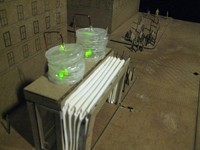--------------------------------------------
i n v e s t i g a t o r s :
Keith Evan Green
Architecture / ECE
Ian D. Walker
Electrical & Computer Engineering
|
 |
Disaster Response
Architectural-Robotic Environments promise to respond effectively to variety of disasters of natural and human origin.
-----------------------------------------------------------------------------------------------------------
 pCAP pCAP
Intelligent Particulate-Control and Air-Purification Environment
Joe Manganelli (Architecture) and Ivan Siles (ECE), Student Investigators
pCAP uses misting devices and/or fire suppression system sprinkler heads, mounted on building parapets, actuated by gas and/or particulate sensors to rapidly generate atmospheric mist in response to
an accidental explosion and/or a terrorist attack. The mist localizes the health risks associated with
hazardous particulate matter, gas and/or a dirty bomb by reducing the extent to which the hazardous
particulates/gases migrate through the city. The proof of concept simulates the misting device but in
actual usage it could be fed by a building’s existing fire suppression system and use standard
components.
Scenario: Bus shelters become safe havens for people caught within the hazardous cloud. A curtain
deploys separating the inside of the bus shelter from the outside and an air filtration system cleanses the
air and pumps the cleaned air down into the shelter. The shelter also deploys masks to provide the
cleansed air to those who cannot fit within the shelter.
The air filtration is symbolized by large “breather” bellows on top of the structure. These breathers are
lit from the inside. As people make their way through the cloud toward the shelter, they are guided by
the light, the movement and the sound of the breathers. People wait at the shelters for rescue. The map
below showing locations of bus shelters throughout Manhattan suggests the potential of utilizing the
existing infrastructure as part of this strategy.
[video]
-----------------------------------------------------------------------------------------------------------
 SIS SIS
Shelter-In-A-Storm Intelligent Response Environment
Adam James (Architecture) and Paul Yanik (ECE), Student Investigators
SIS features a building system that is capable of morphing from a conventional
building skin to a more aerodynamic shape that acts to dissipate the forces of high
wind such as those that occur during a hurricane. A wind sensor detects the
presence of wind gusts above a safe threshold. When such high wind is detected,
the building self-adjusts two important components of its exterior surface: the
parapet walls, and broad, flat wall surfaces. Each of these is flexed to project a
curved (domed) surface toward oncoming wind. The curved surfaces act to dissipate
the wind and thereby reduce the force on the underlying structure as has been
shown to occur with domed buildings. After high winds have died down for a
programmed period of time, the building reverts to its original, more conventional
shape. Lighting is also used to outwardly express the current mode of the structure:
yellow during times of normal (low) wind, and red during emergencies (high winds).
Scenario:
The time before an impending hurricane making land fall in the city of Charleston,
South Carolina had always been tense for its citizens. Many immediately take to the
highways; seeking safety inland without knowing if they would have a home or
business to return to. Many others, who would not travel due to infirmity, poverty,
or misguided hubris, faced the even more worrisome specter of riding out the storm
in the city.
Such was the case for Michael and Joanne Butler. As Michael lay sedated in his second
story room in the Hollings Cancer Center at the Medical College of South Carolina,
Joanne gazed with dread out her window at the now white capped waters of
Charleston Harbor. As the winds increased, she saw the running lights of the
building turn from amber to red indicating emergency status. She heard the gentle
hum of motors slowly arching the building’s windward edges and face to deflect the
fierce winds. She heard the outer panels lock into place as she watched emergency
personnel guide people from the neighboring neighborhood into the building – a
shelter in the storm.
[video]
|
 |










